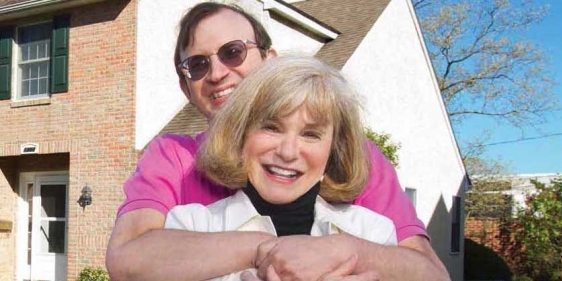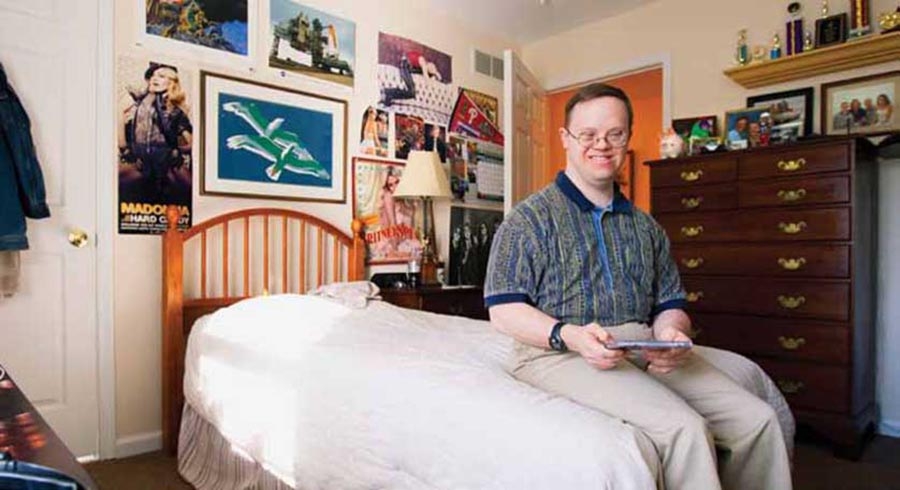Home Improvements

Story by Bruce E. Beans
Photography by Ryan S. Brandenberg
Micki Edelsohn, TYL ’65, was living her life exactly as she had planned it. After graduating from Temple, she married Lanny Edelsohn, a medical student. She taught art for a few years, and figured she would have two children and then continue a career in the arts. But in 1972, Edelsohn‘s plan was upended in a Boston delivery room.
What had been a model pregnancy resulted in the difficult breech birth of her son, Robert. And as he lay in a newborn nursery after the delivery, he stopped breathing. Initially, doctors assured her that he would be all right.
“I knew right away—and certainly by the time he was a year old—that he wasn’t on target for normal development,” she remembers. “I went through denial, anger, sadness. You tell yourself, ‘I can’t do this; it’s not part of the plan.’”
As a result of the breech delivery—and, Edelsohn believes, the episode in the nursery—Robert has intellectual and developmental disabilities.
“Robert has a great sense of humor, but he can’t tie his shoes,” Edelsohn explains. “I know some women say it’s a blessing and that good comes out of it, but it’s difficult—” she pauses profoundly. “There’s fear of the unknown—a fear of, ‘Who’s going to take care of him after I die?’”
That nagging fear drove Edelsohn to take action while Robert was still a teenager.
“My goals for Robert were the same as for [her eldest son] Andrew,” she says. “He’d grow up and be able to live as independently as possible, have a job and be an active member of the community.”
That meant, when the time came, his living in a group home under some kind of supervision. But she did not want him to live in a sparse, institutional building resembling a medical facility that serves a large number of residents—16 or more—whose freedom of choice and movement are often restricted.
LAYING THE FOUNDATION
Edelsohn’s determination for Robert to enjoy his quality of life and relative independence motivated her to raise funds to establish a small, supervised group home he could live in when he reached adulthood.
Because of her vision and resolve, 40–year–old Robert now resides in a warm, welcoming home with the same three men he has lived with since the building was finished in 1996. Within walking distance of the Edelsohns’ home in Wilmington, Del., the dwelling was not the first one his mother erected—and it was far from the last.
Since 1990, Edelsohn and the Homes For Life Foundation—the organization she eventually founded to enhance her fundraising clout—have built 25 attractive group homes in northern Delaware. With four residents per home, 100 adults with intellectual and/or developmental disabilities (ID/DD) between ages 28 and 81 now reside in the houses, along with supervisory staff.
The idea that sparked Homes For Life now reflects a nationwide trend toward small, community–based residences for people with ID/DD who require daily assistance. Between 1992 and 2009, group homes in Delaware for fewer than six residents have increased steadily, while the populations in more traditional institutions have decreased steadily.*
And at a time when 88 percent of adults with ID/DD are unemployed, Edelsohn also has been a catalyst for many of the residents—and many others like them in Delaware—to become employed.
While Robert was still in high school, Edelsohn had raised $65,000 when her new neighbor, MBNA Corp. Founder and CEO Charles Cawley, overheard her talking about the project at a party in 1990. Cawley offered to contribute to the cause and help her complete the house—but only if the residents worked for MBNA, which soon would become the world’s largest independent credit–card company.
Edelsohn felt as if she had won the lottery. With Cawley also enlisting MBNA’s support, the first home was completed only eight months later. But Robert was 18, and not yet ready to move into that home. Edelsohn forged ahead. A second house was finished a year later, and two more followed the second. Robert wound up moving into Edelsohn’s fifth home.
It is difficult to picture the diminutive Edelsohn being satisfied with building only one home anyway. Fiery, big–hearted and frank, she is fiercely committed to the larger cause of improving the quality of life for people with ID/DD, in Delaware and beyond.
The four women who moved into her first home worked in various departments for MBNA. Since then, several hundred people with ID/DD, including Robert, have joined the company’s ranks. When Bank of America acquired MBNA in 2005, it continued the program. Nearly 300 people with ID/DD now work in its Support Services Department, which handles printing, signage, displays, customer mailings and more. Employee duties include digital printing, mounting and trimming large–format signs, silkscreening T–shirts, operating warehouse forklifts and more.
As Edelsohn walks through the Newark, Del., Bank of America facility, it is clear that she is at the heart of this community. Praising a young woman’s recent performance in Totally Awesome Players—the Delaware Theatre Company’s program for people with ID/DD—Edelsohn tells her, “Great acting, Katie.” Like a number of other women, Katie hugs her.
Edelsohn finally announces, “Here is Robert Edelsohn.” Dressed in a blue–striped polo shirt and khakis, a pleasant–looking man with thinning brown hair looks up from his assignment. “Do you know her?” says Mark Feinour, senior vice president for support service at Bank of America. Robert laughs.
DESIGN AND CONSTRUCTION
Edelsohn’s “homes for life” cost as much as $400,000 each to build and furnish. And each home reflects her commitment to environments that appeal to both the residents and the supervisory staff members who work and live there.
“I’m not a builder, but thanks to my art background at Temple, I can visualize,” she says. “I know how to design, modify and decorate homes.” Her husband, whose neurology practice also employs two people with ID/DD, has often found her working in the middle of the night, armed with scissors and Wite–Out, revising builder’s blueprints. After a resident became physically disabled, Edelsohn figured out how to add an elevator to one house. For more independent residents, she divided two of the homes into individual apartments.
“She’s a committed fireball, and the woman never sleeps,” says Rita Landgraf, current secretary of Delaware Department of Health and Social Services (DHSS) and former executive director of The Arc of Delaware, the nonprofit agency that manages and owns the residential properties. “She’s up emailing at 2 a.m.”
After the Homes For Life Foundation builds and furnishes the homes, it deeds them to The Arc of Delaware. Edelsohn’s asking price is $1.
The DHSS supplements operational expenses and works with private agencies to hire home supervisors. Based on their means and Social Security benefits, the residents also contribute to monthly costs.
FROM HOUSE TO HOME
Shortly after 4:30 p.m., a van returns Robert and his co–workers to their two–story brick home on a tree–lined street. Edelsohn stops by to check in on her son. The aroma of a savory noodle dish being prepared by a staff member permeates the first floor.
At one end of the large living and dining room, Fred—who silkscreens T–shirts for Bank of America—is watching The Dr. Oz Show with several women who reside in another of Edelsohn’s homes next door. Lounging nearby is a third housemate, David, who works for McDonald’s. Robert checks his email at a desk opposite handsome black–and–white photographs of the four housemates.
Their spacious bedrooms are located upstairs. A few are covered from floor to ceiling in pictures clipped from magazines, but Robert’s room is tidy. Photo collages are mounted above his bed: Robert taking Rehoboth Beach’s polar–bear plunge as a part of a fundraiser for the Special Olympics; participating in an improvisational skit; and acting in a spoof of Shakespeare, Totally Awesome Hamlet. At the foot of his bed, a basket teems with comic books such as X–Men.
Robert, Kevin (late 30s), Fred (early 60s) and David (late 40s) have lived together for 16 years. Edelsohn says that David, the highest–functioning resident, “could move out tomorrow and live independently.” But he does not want to leave. “I would miss the guys and they would miss me,” he explained to her recently.
Indeed, members of the direct support staff consider the foursome the most cohesive residential unit in the group homes. “Does everybody get along here?” Edelsohn asks.
“Mostly, we do,” Fred laughs.
“Does Robert ever get annoyed?” she asks knowingly, prompting more good–natured laughter.
“Only when his computer doesn’t work,” Fred says.
STRUCTURAL SUPPORT
“What she’s done is really extraordinary,” says Deborah Spitalnik,CLA ’82, who serves with Edelsohn on the President’s Committee for People with Intellectual Disabilities and earned her doctorate in clinical psychology at Temple. The founding executive director of the Elizabeth M. Boggs Center on Developmental Disabilities at the University of Medicine and Dentistry of New Jersey, Spitalnik lauds Edelsohn’s ability to forge partnerships between the public and private sectors in an age of shrinking federal and state resources. Such partnerships are critical for the nearly 8 million people with similar disabilities nationwide.
“Micki has been groundbreaking in this,” Spitalnik says. “It’s clear that there will not be enough government resources to support people in the ways we want to—not only by developing their skills, but also by providing them with the lives they want and those their parents want them to have.”
Edelsohn’s passion and drive are so infectious, it is hard to believe she simply stumbled upon her mission. But, she says, “I just wanted to do something for my son.”
* Braddock, et al., Coleman Institute and Department of Psychiatry, University of Colorado. 2011.
Bruce E. Beans, a freelance writer and editor from Bucks County, Pa., has written for Temple University since 2005.
